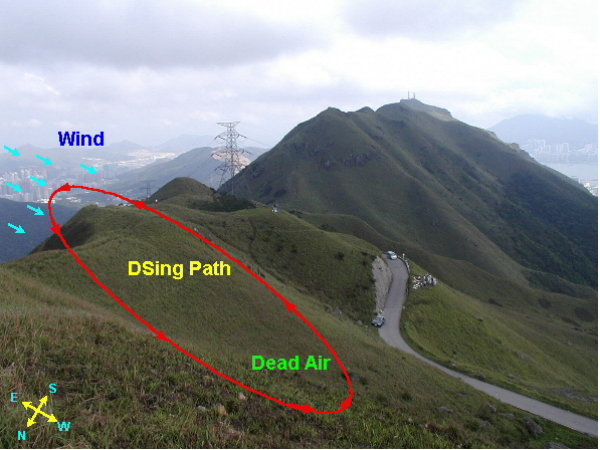Dynamic
Soaring in Fei Ngo Shan |
|||
| Hong Kong has many suitable slopes for R/C soaring,
however, for the hottest activity of dynamic soaring, there are not many choices. In order
to do dynamic soaring we need both the front and back side slopes (see the principle
below). Although the peak in Clearwater Bay is possible for DS'ing, its back site slope is
rather shallow with lots of trees and obstacles in the DS path. The peak in Fei Ngo
Shan however has east slope and southwest slope; both are suitable for dynamic
soaring. In this article we will describe the principle of dynamic soaring and show how we
achieve this in Fei Ngo Shan. |
|||
Principle of Dynamic Soaring The ultimate goal of dynamic soaring is to increase the airspeed of the sailplane by exploiting the difference in speed of adjacent layers of air. In order to do this, we must have two layers of air with difference masses. In the figure shown below, the wind is coming toward the hill from the left and is defected upward by the presence of the hill. The upward air stream is what lifts we use for normal soaring in the front (compressed) side of the hill. As the rapid moving air stream passes the top of the hill, it encounters a dead air zone in the back side of the hill. A separation boundary is then formed between two layers of air; on top is the fast moving air layer and on the bottom is a dead air layer. The separation of the two layers of air is what makes dynamic soaring possible. The glider is flown along a path as shown by the red ellipse in the figure below. The basic idea of dynamic soaring is that the glider is repeatedly flown across the separation layer. On the fast moving layer above the boundary, the glider is flown downwind toward the back of the hill. In addition to its airspeed, it acquires additional ground speed as it is moving downwind. Once it dives down across the separation layer into the dead air zone and continues to turn back to the hill, it encounters no head wind since the air in this layer is dead still. As a result, the lost in speed of the plane is reduced. However, in case if it takes the path back to the hill above the boundary layer, it will encounter strong head wind and will be slowed down significantly; it may never be able to go back to the compressed side of the hill at all! As the plane penetrates the dead air zone and goes back to the fast moving layer near the hill top, it continues to turn and soon it is flown downwind again toward the back of the hill, this will give an extra push of the plane's speed. By repeatedly looping in this way, the speed of the plane will be gradually built up to an incredible rate.
|
|||
| How to do dynamic soaring in
Fei Ngo Shan The peak of Fei Ngo Shan has both east and southwest slopes. On windy day with wind coming from the east, we can do DS'ing on the back (southwest) side of the peak as shown in the picture below. The east side slope here is rather steep, this is the slope that we normally use for flying our gliders. The southwest slope is rather shallow, however, it is deep enough for us to do serious DS'ing. The red circle shown in the picture is the path that we use for DS'ing when the wind is coming from the east. We start by launching the glider on the east side slope and then gradually build up the attitude. With a deep breath, the plane is maneuvered to dive downwind toward the southwest slope (near the camera position in the picture). Be careful that there is a small hill close to the DS'ing path in the north, i.e., the one that we stood and took this picture. After passing this hill you should maneuver the plane down to fly across the separation layer into the dead air zone as shown in the picture. Then, the plane is heading back toward the hill top in the dead air zone. Immediately after it comes up from the top, you should turn it to fly downwind again toward the southwest and repeat the course again. If you can master this pattern of flying, your plane will gain tremendous ground speed of over 100mph! Good luck and have a try.
|
|||
| See dynamic soaring movies taken from this site. The daring pilots are Raymond Wong and Stanley Chan | |||
 |
 |
||
| Warning: Dynamic
soaring is an extremely dangerous sport as DS'ing sailplane travels closed to the ground
in very high-speed, a small mistake will have a disaster result. Please see some pictures
of sailplanes' crumbs as a result of DS'ing. crumb1.jpg, crumb2.jpg |
|||
|
|
|||



